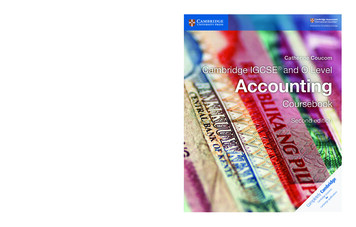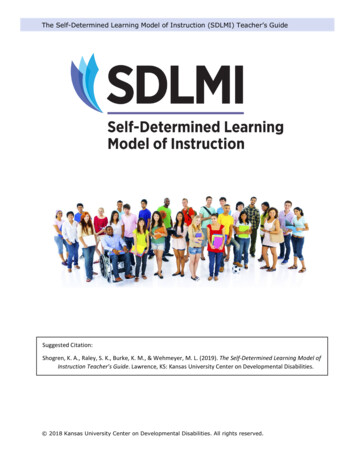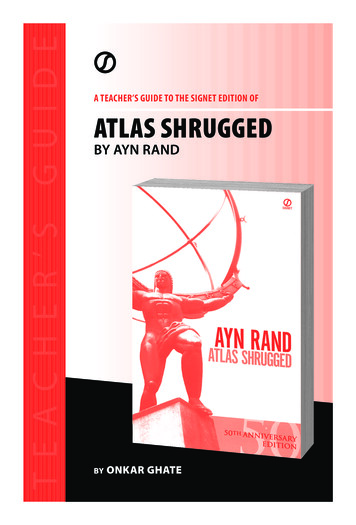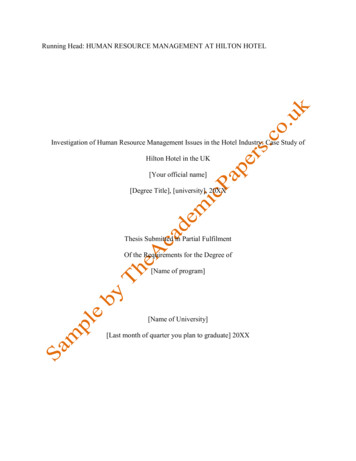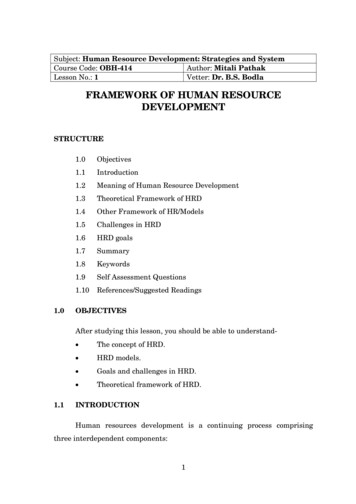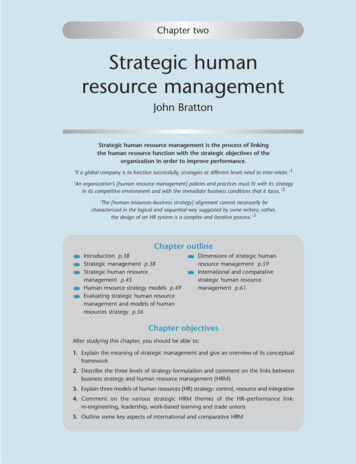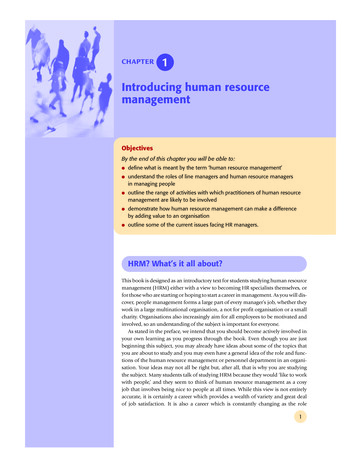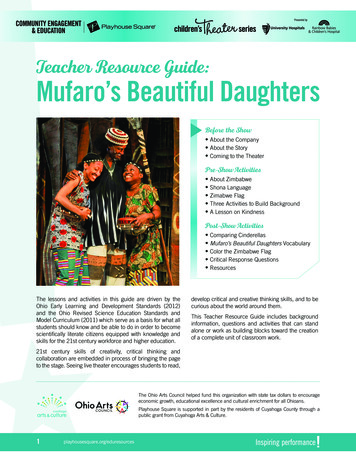
Transcription
Teacher Resource Guide:Mufaro’s Beautiful DaughtersBefore the ShowAbout the CompanyAbout the StoryComing to the TheaterPre-Show ActivitiesAbout ZimbabweShona LanguageZimabwe FlagThree Activities to Build BackgroundA Lesson on KindnessPost-Show ActivitiesComparing Cinderellas Mufaro’s Beautiful Daughters Vocabulary Color the Zimbabwe Flag Critical Response Questions ResourcesThe lessons and activities in this guide are driven by theOhio Early Learning and Development Standards (2012)and the Ohio Revised Science Education Standards andModel Curriculum (2011) which serve as a basis for what allstudents should know and be able to do in order to becomescientifically literate citizens equipped with knowledge andskills for the 21st century workforce and higher education.develop critical and creative thinking skills, and to becurious about the world around them.This Teacher Resource Guide includes backgroundinformation, questions and activities that can standalone or work as building blocks toward the creationof a complete unit of classroom work.21st century skills of creativity, critical thinking andcollaboration are embedded in process of bringing the pageto the stage. Seeing live theater encourages students to read,The Ohio Arts Council helped fund this organization with state tax dollars to encourageeconomic growth, educational excellence and cultural enrichment for all Ohioans.Playhouse Square is supported in part by the residents of Cuyahoga County through apublic grant from Cuyahoga Arts & Culture.1playhousesquare.org/eduresources
ABOUT THE SHOWABOUT THE STORYDALLAS CHILDREN’S THEATER, one of the top five familytheaters in the nation, serves more than 250,000 youngpeople each year through its 11 main stage productions,touring, educational programming and outreach activities.Since its opening in 1984, this award-winning theater hasexisted to create challenging, inspiring and entertainingprograms which promote an early appreciation forliterature and the performing arts. As the only majororganization in Dallas focusing on theater for youth andfamilies, DCT produces literary classics, original scripts,folk tales, myths, fantasies and contemporary dramasthat foster multicultural understanding, confront topicalissues and celebrate the human spirit.Mufaro’s Beautiful Daughters, performed by the DallasChildren’s Theater, is based on the award-winning children’sbook by John Steptoe and adapted for the stage by KarenAbbot. In the story, Mufaro lives in a small African villagewith his two lovely, but very different daughters. His eldestdaughter, Manyara, is selfish, mean-spirited and unkind toher younger sister, Nyasha, who is beloved for her patienceand generosity. One day, the Great King announces he isseeking a wife and invites all worthy and beautiful youngwomen to come to the city to meet him. Manyara and Nyashamake the journey through the forest to the city separately.Along the way, each daughter meets strange creatures andfaces many challenges. In the end, Manyara’s pride defeatsher, while Nyasha’s goodness leads her to become queen.2playhousesquare.org/eduresources
Coming to the TheaterPlayhouse Square is an exciting field trip destination! Asthe country’s largest performing arts center outside of NewYork, the not-for-profit Playhouse Square attracts morethan one million guests to 1,000 performances and eventseach year. Playhouse Square thus acts as a catalyst foreconomic growth and vitality within the region. When youvisit, be sure to note the GE Chandelier, the world’s largestoutdoor chandelier, and the retro Playhouse Square signwith its 9-foot-tall letters!As audience members, you and your students play a vitalrole in the success of the performances. You are part of acommunity that creates the theater experience. For manystudents, this may be their first time viewing a live theaterproduction. We encourage teachers to discuss some of thedifferences between coming to the theater and watchinga television show, attending a sporting event or viewinga movie at the cinema. Here are a few points to start thediscussion: Students are led into the theater and seated by an usher. heaters are built to magnify sound. Even the slightestTwhisper can be heard throughout the theater. Rememberthat not only can those around you hear you; theperformers can too. ppropriate responses such as laughing or applaudingAare appreciated. Pay attention to the artists on stage; theywill let you know what is appropriate. There is no food, drink or gum permitted in the theater. hotography and videotaping of performances is notPpermitted. hen the houselights dim, the performance is about toWbegin. Please turn your attention toward the stage. fter the performance, you will be dismissed by busAnumber. Check around your seat to make sure you haveall of your personal belongings.An excitingdestinationfor field tripsand more!3playhousesquare.org/eduresources
Pre-Show ActivitiesABOUT ZIMBABWE4GeographyThe country of Zimbabwe strongly influenced Mufaro’s Beautiful Daughters.Zimbabwe is in the southeast portion of Africa, bordered by Mozambique, Botswana,South Africa, and Zambia.HistoryAs the author of Mufaro’s Beautiful Daughters, John Steptoe drew ideas for theillustrations in his book from the ruins of the ancient city of Great Zimbabwe and thesurrounding region. Located in present-day southeastern Zimbabwe, the vast city wasbuilt between the 11th and 15th centuries. The mysterous ruins offer a fascinatingway to explore Africa’s history.EnvironmentThe home of Murfaro and his daughters is a small village in a thriving rainforest. Thevillagers live in harmony with their environment. Nyasha, the daughter of Mufaro,tends her garden of millet, sunflowers, yams, and vegetables, and it is there shebefriends Nyoka the snake.ClothingThe costumes worn in the production reflect traditional Africandress. Woven fabric known as kente cloth that originated in Ghanais widely used in traditional African dress including some of thecostumes in the Dallas Children’s Theater production.playhousesquare.org/eduresources
SHONA LANGUAGEShona language: The names of the characters in Mufaro’s Beautiful Daughters are from the Shona language spokenin Zimbabwe:Mufaro (moo-far-oh) – “happy man”Manyara (mahn-YAR-ah) – “ashamed”Nyasha (nee-AH-sha) – “mercy”Nyoka (nee YO-ka) – “snake”Chuma – “wealth”Rudo – “love”Betserai – “help me”Tichawonna – “we shall see”Zimbabwe FlagThe flag of Zimbabwe has seven equal horizontal bands of green, yellow, red, black, red, yel low and green. It containsa white isosceles triangle edged in black with its base on the hoist side.Symbolism within the Zimbabwe FlagA yellow Zimbabwe bird: Represents the long historyof the countryRed five-pointed star: PeaceGreen: AgricultureYellow: Mineral wealthRed: Blood shed to achieve independenceBlack: Stands for the Native people5playhousesquare.org/eduresources
THREE ACTIVITIES TO BUILD BACKGROUND1. R ead John Steptoe’s book Mufaro’s Beautiful Daughtersaloud. Ask students to describe and respond to hisvivid illustrations. Have students imagine the sounds,smells, light and movement of the world in the bookand consider how these aspects of the story mightcome to life onstage.2. M ufaro’s Beautiful Daughters is set in the country ofZimbabwe on the continent of Africa. Allow students tospend time with a world map or globe and locate theAfrican continent and the country of Zimbabwe. Usethe following questions to encourage students to makeinferences:W hat kind of climate do you think Zimbabwe has?How would you compare it to ours?What sorts of landscape might you find?What animals could be found in Zimbabwe?Is Zimbabwe north or south of the equator?What are some neighboring countries?6playhousesquare.org/eduresources3. A sk children if they have ever heard languages otherthan their own spoken. Give them the opportunity toshare with the class other languages that they mayknow. Then emphasize that language is only onedifference that may exist between people of differentcultures.Educational materials provided, in part, by the NewJersey Performing Arts Center and learningtogive.org.
Educational materials provided, in part, by the NewJersey Performing Arts Center and learningtogive.org.College and Career Readiness Anchor Standards forReadingAssess how point of view or purpose shapes the contentand style of a text.RL.K-6.1, RL.K-6.2, RL.K-6.3Social Studies – Kindergarten-Grade 8Strand: GeographyTopic: Spatial Thinking and SkillsA Lesson on KindnessPurpose:To expose children to an African folktale that teaches thebenefits of kindness.Duration:One 30-Minute Class PeriodObjectives:The learner will:analyze acts of kindness and selfishness.place events of the story in their proper sequence.describe the setting.trace a route on a map that shows rivers and mountains.Materials:Physical map of AfricaMufaro’s Beautiful Daughters by John SteptoeSynopsis:Mufaro’s Beautiful Daughters is the story of a king whois looking for a wife. The person has to be worthy andbeautiful. Mufaro has two daughters. Both are beautiful,but one is selfish and bad-tempered and the other is kind.The king tests the daughters without their knowledge todetermine which is most worthy. This story’s illustrationsexpose the children to early African scenery as well as away of life different to their own.Instructional Procedure(s):Anticipatory Set:Ask the children if they should be kind even if no one islooking. Give some examples of quiet kind acts that couldbe done without anyone knowing you have done them.Discuss why you would choose to do them when no onewould be there to acknowledge your kind deed. old up the cover of the book Mufaro’s BeautifulHDaughters. Activate prior knowledge by asking childrento describe what they see. Read the book to the class. Discuss the artwork andthe different types of wildlife that are seen on eachpage. Ask students why the environment in the booklooks different from where they live. On selected pages, stop and encourage the students tointeract with the book in the following ways: hypothesizeabout what may happen next, what the motives of thecharacters might be, and why something is happening. Have children discuss other solutions that may havebeen tried and predict what the consequences wouldhave been. Reread the book, inviting the children to add furthercomments on what they see and think about thestory. Ask students why a king would want to makesure that his country’s future queen would not be aselfish person. Have students sequence the trials that both girlsencountered on their journeys and analyze howeach girl responded as either unselfish or selfish.They can list the events or draw pictures showingthe trials in their journeys.T race the route traveled by the girls on a physicalmap to show rivers and mountains.Assessment:Observe how students participate in the discussions ofdetails in the story. Observe students’ ability to list thetests that each girl encountered and analyze her actions.Cross-Curriculum Extensions:Spend some time looking at the map of Africa with thestudents. Read the names of the countries and talk aboutdifferent regions and their climates and wildlife.7playhousesquare.org/eduresources
Post-Show ActivitiesCollege and Career Readiness Anchor Standards forReadingAnalyze how two or more texts address similar themesor topics in order to build knowledge or to compare theapproaches the authors take.RL.K-6.9Comparing CinderellasA folktale is a story that has been told again and again, andeventually written down. Sometimes the same story getstold in different parts of the world. There are thousandsof versions of the Cinderella story. Mufaro’s BeautifulDaughters is an African folktale. Author and illustratorJohn Steptoe created Mufaro’s Beautiful Daughters from astory collected by G. M. Theal when he was in Africa, andpublished in 1895 in his book Kaffir Folktales. Mufaro’sBeautiful Daughters is called a “Cinderella” story because itis about a young woman living in unfortunate circumstancesthat suddenly change to fortunate circumstances. This onetakes place in Zimbabwe, Africa and it teaches us aboutZimbabwe’s people, plants, animals, and even an ancient city.After you read the tale of Mufaro’s Beautiful Daughters, read the classic fairytale Cinderella.Then do the following worksheet.Mufaro’s Beautiful DaughtersThe classic Cinderella StoryDescribe the sister:Describe the stepsisters:Friends or people who help:Friends or people who help:Magic PersonMagic PersonWhat is the test that shows the rightful“Cinderella character?”What is the test that shows the rightful“Cinderella character?”How does the king/prince find out who Nyasha is?How does the king/prince find out who Cinderella is?What is different? (No ball to attend, no dress to acquire, no cruel step-mother)W hat’s the same? (Cinderella finds joy in her life, treats all living things with kindness, and is eventually rewarded for hergoodness)D iscuss how “good always wins over bad” is a theme shared by different cultures. (Although from very different backgrounds,all human beings in all cultures have a sense of right and wrong and a sense of justice and kindness.)8playhousesquare.org/eduresources
College and Career Readiness Anchor Standards forLanguageDetermine or clarify the meaning of unknown and multiplemeaning words and phrases by using context clues,analyzing meaningful word parts, and consulting generaland specialized reference materials, as appropriate.L.K-6.4MUFARO’S BEAUTIFUL DAUGHTERS VOCABULARYThese words may be unfamiliar to your eplumedgarmentsenclosurechamberActivity/Word SearchTry this activity to help make some of the unfamiliar wordsin the story familiar. Have students work with partners orin small groups. Assign each team a page or two in thebook, and ask them to identify four or five words that theyfind difficult.Provide dictionaries and tell the teams to look up theirwords and write them on a sheet of paper. Next, havestudents pass around the paper so that each teammember can write a sentence using the word. Concludeby having the teams present their words and sentencesto the class.9playhousesquare.org/eduresources
COLOR THE ZIMBABWE FLAGThe flag of Zimbabwe has seven equal horizontal bands of green, yellow, black, red, yellow and green. It contains awhite isosceles triangle outlined in black with its base on the hoist side. A yellow Zimbabwe bird: Represents the long history of the country Red five-pointed star Peace Green Agriculture Yellow Mineral wealth Red Blood shed to achieve independence Black Stands for the Native e.org/eduresources
Critical Response QuestionsStudents develop their comprehension when they reflect upon what they wondered, noticed and felt. Ignite a classroomdiscussion with the following critical response questions:1. Reflection: In discussing a performance, it is oftenmore productive to ask the question “What did yousee in the production?” or “What do you remembermost strongly?” rather than “Did you like it?” The firsttwo questions lead to observation or analysis of theperformance, encouraging recall of details, while thethird question encourages more judgmental responses.Although audience members respond positively and/ornegatively to a work of art, critique should come in laterin the discussion process. Discussion of which aspectsof a performance remain in one’s memory oftenreveals the artistic choices at the heart of a work. Havestudents describe a memorable moment from the playin various ways - verbally, in writing, by drawing, orthrough movement.2. Ask students what lesson they think Mufaro’s BeautifulDaughters is trying to teach (“People who demeanothers do not win in the end;” “You reap what yousow;” “Pretty is as pretty does;” “Beauty is in the eyeof the beholder”). Students may find other lessons,too. Have students write a paragraph explaining theiranswer.3. Discuss and make a list of some ways that you canshow kindness to people you live with, friends andstrangers:A re the acts of kindness the same for each groupof people?B e sure to think of small acts of kindness as well asa bigger act that may involve some time and givingup an opportunity for yourself.M ake a plan to do some of the things on your list.A fter some time, come back to talk about the listagain. Did you do some of the things you planned?How did you feel? How did the people you werekind to react? Can you add some ideas to your list?11playhousesquare.org/eduresources4. Draw a picture or diagram showing the sequence ofthe trials that both girls encountered on their journeys.Analyze how each girl responded to each trial. Thinkof words to describe each action, such as proud,generous and afraid.5. What does it mean to get what you deserve? Did thesisters get what they deserved? Was it fair that Nyashabecame queen? Was it fair that Manyara became aservant in her household? Do you think this idea is real?Do you feel that you get what you deserve? Do you treatpeople the way you want to be treated or do you treatthem the way they treat you? What is the best policy?6. Explore the relationship between Manyara and Nyasha.Ask children to describe the way Manyara felt about hersister. Ask: hy was Manyara jealous of her sister?W What could Manyara do about her feelings?7. Encourage children to discuss feelings of jealousy andanger that they may have had toward siblings or others.Also have children share with everyone the things theymay have done to resolve these feelings. Ask: hy do you think Nyasha was chosen as queen?W What kind of queen do you think Nyasha will be? What kind of queen would Manyara have been if shehad been chosen instead? How do you think Manyara felt about being a servantto Nyasha? What do you think might have happened to Manyaraif she had behaved differently?Educational materials provided, in part, by the KravisCenter.
RESOURCESBooksWeb Sites(Grade Levels Included)Abadeha: The Philippine Cinderella by Myrna J. de laPaz (Author), Youshan Tang (Illustrator). Lee & Low Books(May 1, 2014). /mufarosbeautiful-daughters-lesson-planAdelita by Tomie dePaola (Author, Illustrator). Puffin Books;Reprint edition (August 3, 2004). Pre-K-3.https://www.youtube.com/watch?v pXPV35dah8ICendrillon: A Caribbean Cinderella by Robert D. SanSouci (Author), Brian Pinkney (Illustrator). Aladdin; Reprintedition (January 1, 2002). K-5.Cinderella by Marcia Brown (Author, Illustrator). Aladdin; 2edition (April 1, 1997). Pre-K-3.The Egyptian Cinderella by Shirley Climo (Author), RuthHeller (Illustrator). HarperCollins; Reprint edition (February28, 1992). Pre-K-3.http://www.teachingbooks.net/tb.cgi?tid 4749&a 1About ZimbabweThe Country of Zimbabwehttp://www.studentsoftheworld.info/country information.php?Pays ZIMThe Geography of Zimbabwehttp://www.geographia.com/zimbabwe/The Products and Economy of /zimbabwe/default.htmThe Golden Sandal: A Middle Eastern Cinderella Storyby Rebecca Hickox (Author), Will Hillenbrand (Illustrator).Holiday House (August 1, 1999). K-3.The Language of Zimbabwehttp://www.ethnologue.com/show language.asp?code snaThe Irish Cinderlad by Shirley Climo (Author), LorettaKrupinski (Illustrator). HarperCollins; Reprint edition(January 26, 2000). K-4.Apps for AfricaThe Korean Cinderella by Shirley Climo (Author), RuthHeller (Illustrator). HarperCollins (January 18, 1996). K-3.The Orphan: A Cinderella Story from Greece by AnthonyManna (Author), Christodoula Mitakidou (Author), GisellePotter (Illustrator). Schwartz & Wade (October 11, 2011).Pre-K-3.The Princess and the Pea by Rachel Isadora (Author).Puffin Books; Reprint edition (May 14, 2009). Pre-K-3.Rapunzel by Rachel Isadora (Author, Illustrator). G.P.Putnam’s Sons Books for Young Readers; Reprint edition(October 16, 2008). Pre-K-1.The Rough-Face Girl by Rafe Martin (Author), DavidShannon (Illustrator). Puffin Books; Reissue edition (April13, 1998) 3 and up.The Twelve Dancing Princesses by Rachel Isadora (Author,Illustrator). Puffin Books; Reprint edition (November 12,2009). K-3.Yeh-Shen: A Cinderella Story from China by Ai-Ling Louie(Author). Puffin Books; 1 edition (May 7, 1996) Pre-K-3.12playhousesquare.org/eduresourcesAfrica – Animal Adventures for KidsThis app turns kids into little wildlife, animaland plant experts and will inspire the wholefamily! Discover more than 40 Africananimals in 3 settings with interesting facts. Tap each animalfor amazing animations and sounds. Fully narrated in 12languages. iTunes 2.99African ProverbsPearls of Wisdom: African Proverbs is curatedby Dr. Madanmohan Rao. This compilationpresents a glimpse into the culture andlinguistic diversity of Africa. 2,000 proverbs from across thelength and breadth of Africa as well as 125 categories oflanguages, countries and ethnic groups. Android FREEMap Puzzle for KidsThis educational map game teaches kids thenames, shapes and locations of countries aswell as how to pronounce them. It features 15 beautiful mapsfrom the continents of North America, South America, Asia,Africa and Europe. The first 5 puzzles are free, and the rest ofthe game is unlockable for a single in-app purchase. iTunesFREE
A folktale is a story that has been told again and again, and eventually written down. Sometimes the same story gets told in different parts of the world. There are thousands of versions of the Cinderella story. Mufaro’s Beautiful Daughters is an African folktale. Author and illustrator


